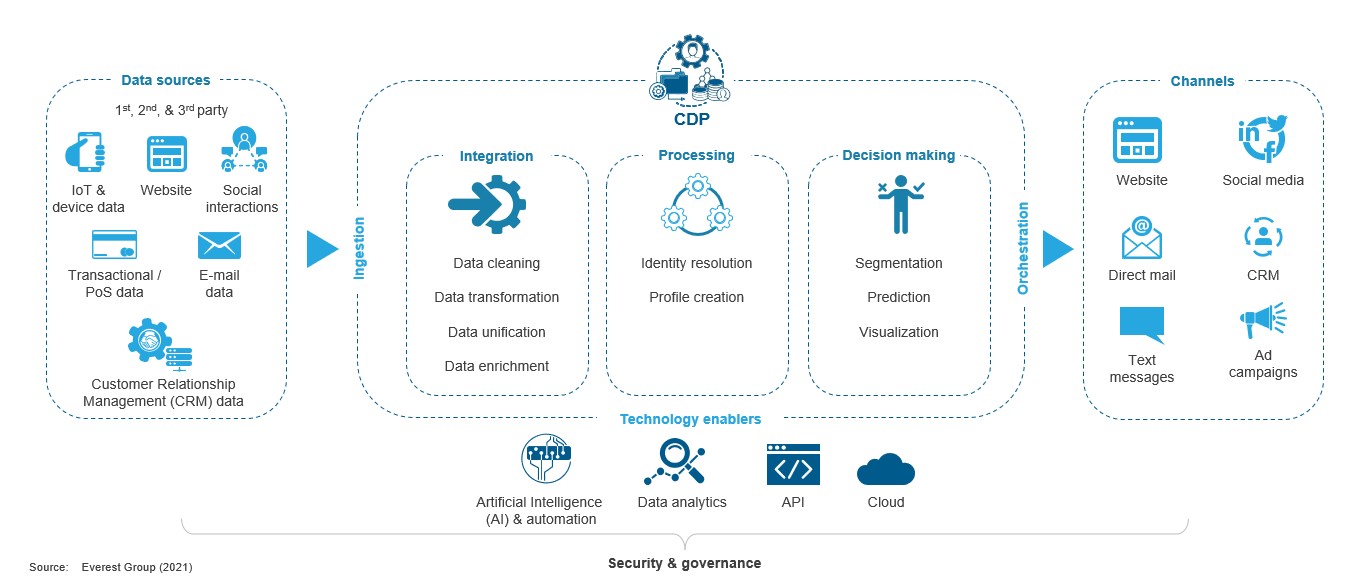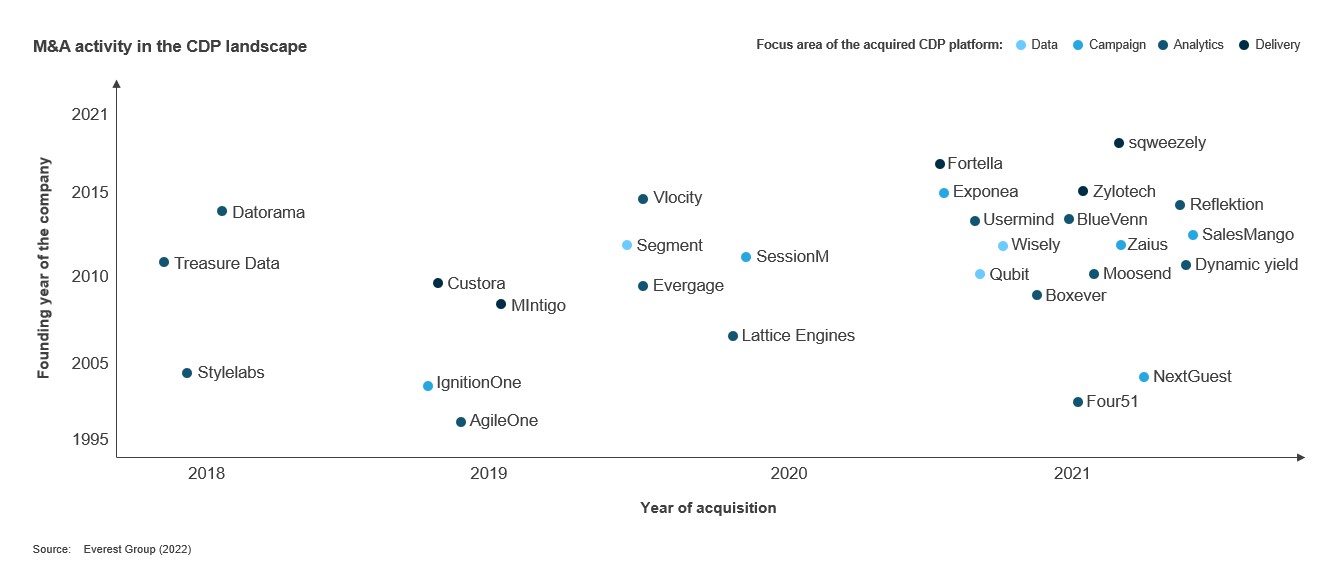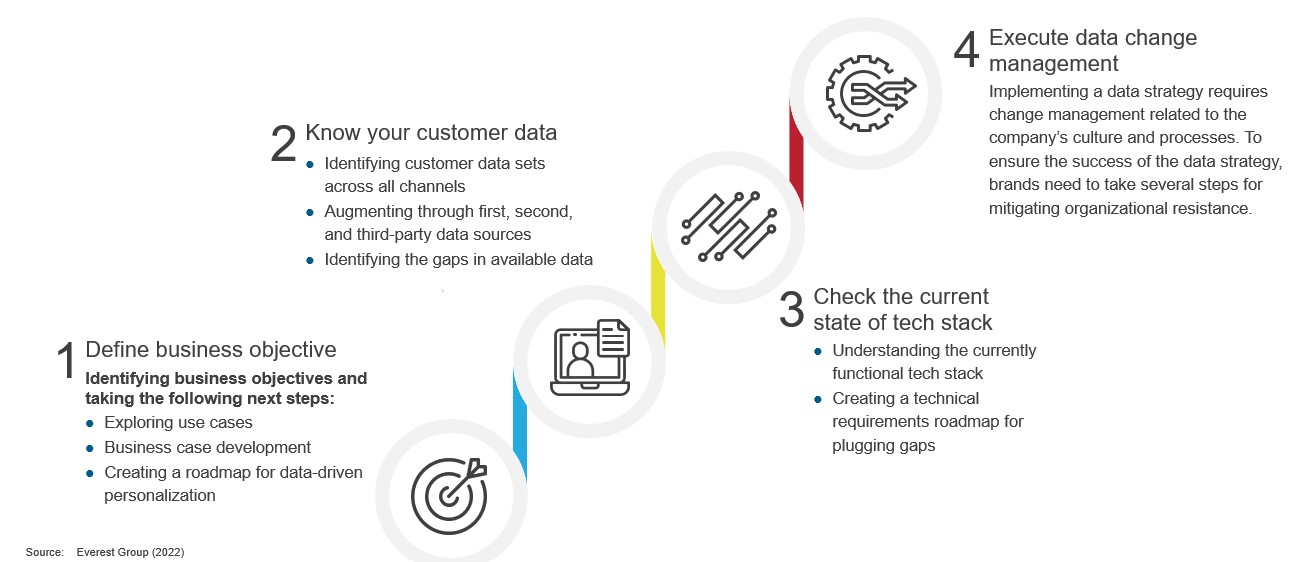The Rising Role of Customer Data Platforms in Data-driven Personalization

By bringing together disparate data to gain a single customer view, Customer Data Platforms (CDPs) are becoming increasingly important to help brands drive personalized marketing efforts while maintaining trust and privacy. Learn more about the benefits of Customer Data Platforms and why they matter in this blog.
With the explosion of data on consumers’ spending and online behavior available from a multitude of sources today, gleaning valuable insights from the massive amounts of information is a top priority for brands.
But unifying the various disconnected touch points clearly and comprehensively to make sense of all the data is one of the biggest challenges facing marketers.
Customer Data Platforms (CDPs) have emerged as an important software solution that can help businesses get closer to consumers and achieve their organizational goals. Let’s explore what is driving the rise of CDPs.
Shift to data-driven marketing
Third-party cookies stored within users’ browsers have historically been a key marketing technology to track visitor behavior activity, improve the user experience, and collect metadata.
But today’s new consumer priorities, data privacy laws, and evolving technologies are leading to the third-party cookie’s demise. Following Safari’s lead in 2016, the world’s three main browsers eliminated (or will eliminate) the use of third-party cookies.
In addition to the demise of third-party cookies, other developments are limiting the use of consumer data for marketers. On the mobile/tablet devices side, Apple’s iOS 14 now requires explicit consent for any mobile identification collection.
The General Data Protection Regulation (GDPR) in Europe and other similar regulations are impacting consumer data collection and processing. In addition, 71% of countries have data protection and privacy regulations and 9% have draft legislations, according to the United Nations Conference on Trade and Development (UNCTAD.)
These developments significantly impact the consumer targeting capabilities of advertisers who often depend on third-party data. The vast majority of advertisers use or have used retargeting and old-generation Data Management Platforms (DMPs) that rely heavily on segments fed by third-party data.
Along with targeting, measurement is also significantly hindered. With more stringent consent collection requirements, collecting the consumer identifications needed to track impressions, clicks, or views and reconstruct complete customer journeys is more difficult.
These changes represent a major shift in data-driven marketing – leading to greater reliance on first- and second-party data to meet the challenges of an increasingly privacy-focused world.
But the unfortunate reality is that most organizations simply aren’t ready to adapt to these trends.
In our report Emergence of CDPs: Charting the Path to Data-driven Personalization, we estimate that even though 90% of businesses agree that data-driven marketing is the future, only 20% consider themselves highly mature enterprises, citing the high cost of data acquisition, limited automation, and data fragmentation as some of the top challenges.
How can enterprises prepare?
With this imminent shift from third-party to first- and second-party data, the changing regulatory environment, and evolving customer expectations for omnichannel and hyper-personalized experiences, enterprises are actively investigating new ways of collecting and activating customer data to drive personalization while fostering customer trust.
This is where CDPs become increasingly important and act as a central repository for the marketing stack.
A CDP allows enterprises to capture and store user data to link with all the users’ interactions, including Customer Relationship Management (CRM) and eCommerce platforms, social media, websites, and apps. Having data from multiple different systems improves the likelihood of identifying an individual. See the customer data platform framework below:
Customer data platform framework
By gaining a single customer view, brands can better understand customer requirements and up-to-date communications preferences, personalize individual brand experiences based on past behavior, and create personalized recommendations for customer segments. All of this can be achieved using unique, relevant, and accurate information that a person has willingly shared with the brand.
CDPs do not replace existing data systems. Instead, their role is to enhance current tools’ capabilities, mitigate risk from the third-party cookie demise, and power marketing teams with near real-time best-in-class audience selection. CDPs bring together existing customer data, anonymous floating attributes, and digital behavior across channels, devices, and tools.
Customer data platform landscape
Adoption is on the rise with, CDPs being viewed by enterprises as one of the most viable, future-proof solutions for managing the overwhelmingly disparate data streams that today’s brands gather and generate about their consumers and prospects.
Enterprises have many choices in this rapidly expanding market, including:
- Large enterprises like Adobe, Oracle, and Salesforce that are investing hundreds of millions of dollars in the space and offer CDP as part of a greater MarTech (marketing technology) package
- Pure play CDP players like Celebrus, mParticle, and Treasure Data that are purpose-built to support and address CDP use cases first that don’t need to be integrated into a larger system
Along with the growth in new entrants, the CDP space has seen a flurry of merger and acquisition activity in recent years of players that have showcased their unique data, campaign, analytics, and delivery capabilities, as illustrated below to see merger and acquisition activity in the customer data platform landscape.
Merger and acquisition activity in the customer data platform landscape
The road ahead for customer data platforms
As the data management landscape continues to rapidly evolve, CDPs will play an important role in the marketing tech stack and enable marketers to achieve true 1:1 personalization.
For enterprises to reach the desired business outcomes and mitigate risks in their personalization journeys, they should follow a comprehensive roadmap with the following four steps for data-driven 1:1 personalization:
Roadmap for data-driven 1:1 personalization
For more, see our report, Emergence of CDPs: Charting the Path to Data-driven Personalization, or view our webinar, Hyper-personalization Using Customer Data Platforms (CDPs). To discuss Customer Data Platforms further, please reach out to Sandeep P at [email protected].
Discover how CX leaders can meet the expectations of their digitally enabled customers in our webinar, How are Leading Organizations Delivering Exceptional Customer Experience?


